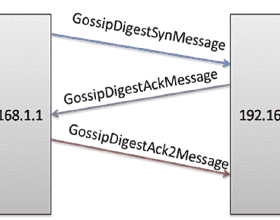We consider a network consisting of a single source and $n$ receiver nodes that are grouped into $m$ equal size communities, i.e., clusters, where each cluster includes $k$ nodes and is served by a dedicated cluster head. The source node keeps versions of an observed process and updates each cluster through the associated cluster head. Nodes within each cluster are connected to each other according to a given network topology. Based on this topology, each node relays its current update to its neighboring nodes by $local$ $gossiping$. We use the $version$ $age$ metric to quantify information timeliness at the receiver nodes. We consider disconnected, ring, and fully connected network topologies for each cluster. For each of these network topologies, we characterize the average version age at each node and find the version age scaling as a function of the network size $n$. Our results indicate that per node version age scalings of $O(\sqrt{n})$, $O(n^{\frac{1}{3}})$, and $O(\log n)$ are achievable in disconnected, ring, and fully connected networks, respectively. Finally, through numerical evaluations, we determine the version age-optimum $(m,k)$ pairs as a function of the source, cluster head, and node update rates.
翻译:我们考虑一个由单一源和美元接收器节点组成的网络,这些节点分组为美元等大小社区,即组群,每个组群包括K美元节点,由专门的组群头提供服务。源节点保存观察过程的版本,并通过相关组群头更新每个组群。每个组群内的节点根据给定的网络型态相互连接。根据这个表层,每个节点用美元将当前更新转至邻近节点。我们用美元来量化接收点节点的信息及时性。我们考虑每个组群的断、环形和完全连接的网络型号。对于每个网络组群,我们描述每个节点的平均版本年龄,发现版本年龄缩放是网络规模的函数 $。我们的结果显示,每个节点将当前更新的时间缩放由美元转至美元(ncolost {%3}。我们使用美元来量化接收点节点节点的信息及时性。我们考虑每个组群点的断、环形和完全连接的网络的网络表位、最后年龄和数字的频率,我们通过链接和数字的周期确定。




